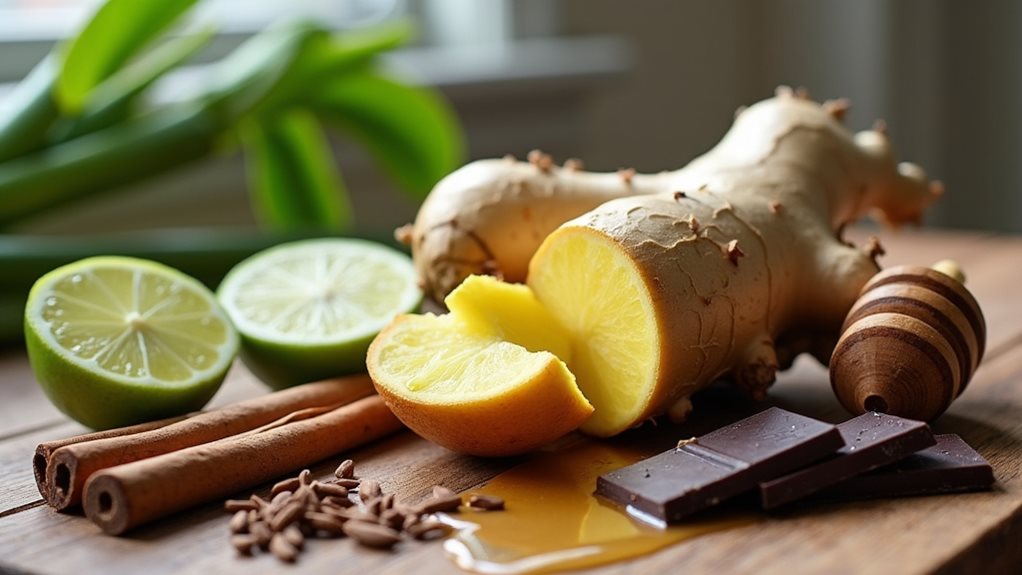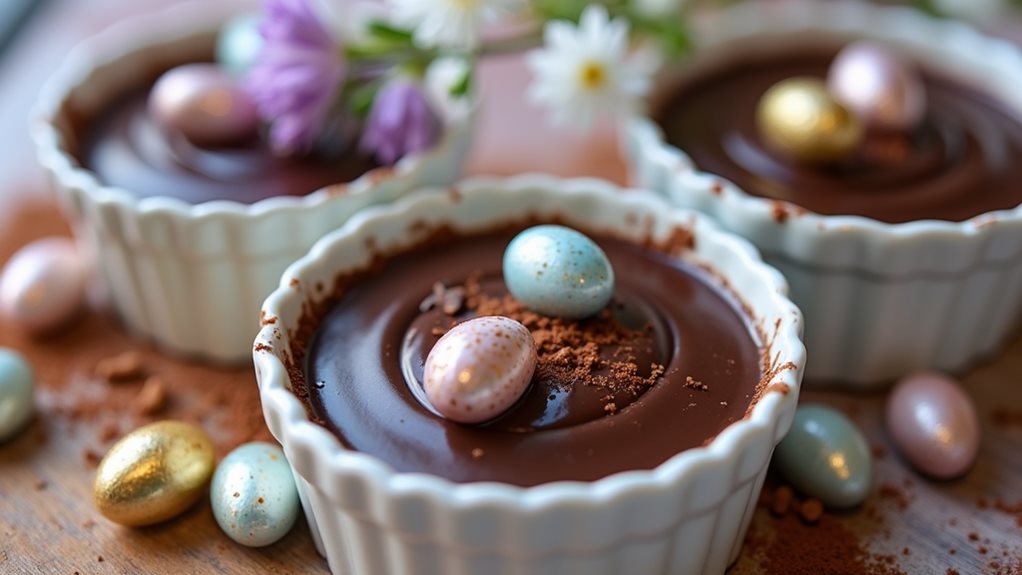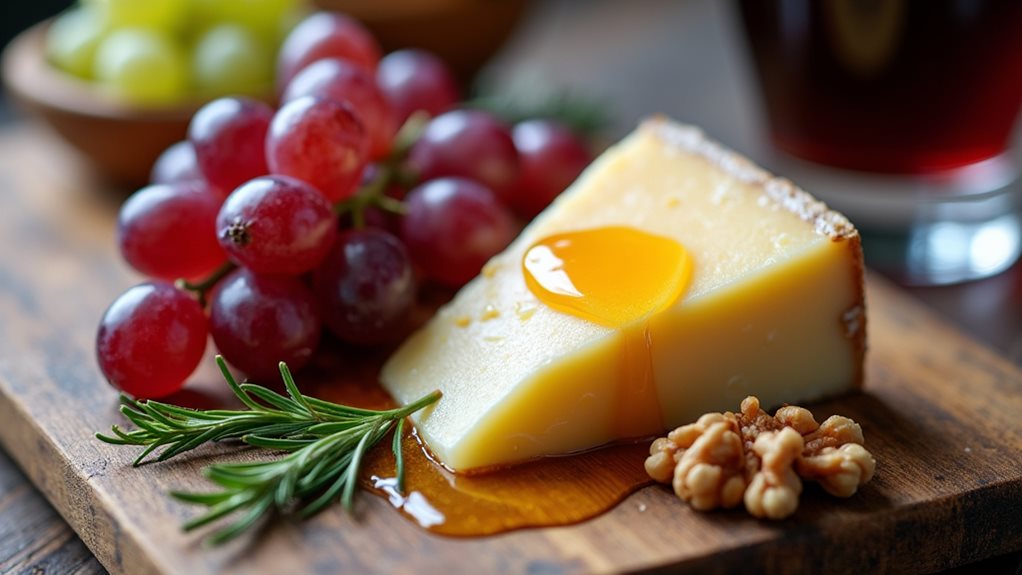Ginger pairs wonderfully with both sweet and savory ingredients. For sweet applications, try combining it with citrus, honey, chocolate, or warm spices like cinnamon and nutmeg. In savory dishes, it complements soy sauce, garlic, scallions, and coconut milk. You'll find it works particularly well with chicken, seafood, and vegetables like carrots and sweet potatoes. Don't forget about beverages—ginger enhances teas, cocktails with bourbon or rum, and fresh fruit juices. The perfect pairings await in every cuisine.
The Science Behind Ginger's Flavor Profile

While many enjoy ginger's distinctive warmth and spiciness, the complex chemistry behind its flavor profile makes it truly fascinating.
The ginger chemistry responsible for its pungency centers on compounds called gingerols, which are chemically related to capsaicin in chili peppers.
When you cook with ginger, you're initiating remarkable flavor transformations. Heat converts gingerol to zingerone, creating a milder, sweeter taste. This transformation occurs through a reverse aldol reaction that contributes to the characteristic aroma found in baked goods like gingerbread.
Drying ginger, however, transforms gingerol into shogaols—compounds nearly twice as pungent as their precursors. That's why dried ginger delivers a more intense heat than fresh.
You'll also find aromatic compounds like zingiberene contributing to ginger's complex profile.
These elements work together to create that characteristic warming sensation you feel, along with subtle citrus undertones that make ginger incredibly versatile in your culinary creations. This versatility allows ginger to bridge diverse traditions across global cuisines, making it a unifying ingredient in international flavor explorations.
Essential Ginger Pairings for Sweet Treats
You'll discover a world of flavor magic when pairing ginger with complementary ingredients in your sweet creations, from the classic apple-ginger combination in pies to the luxurious blend of chocolate and ginger in cookies.
In your home baking adventures, try matching ginger with honey, citrus, or maple for balanced sweetness, or experiment with unexpected partners like lavender and basil for more complex flavor profiles. The warming qualities of ginger make it particularly appealing in fall season desserts when combined with traditional spices like cinnamon and cloves. Using the proper dicing techniques when preparing fresh ginger will ensure even distribution of flavor throughout your baked goods.
For afternoon tea gatherings, serve ginger-infused treats like lemon-filled ginger sandwich cookies or coconut-ginger ice cream to impress your guests with sophisticated yet accessible flavor combinations.
Dessert Symphony
Ginger transforms ordinary desserts into extraordinary culinary experiences when paired with complementary flavors that enhance its natural warmth and spice. The ginger flavor creates complexity in your sweet creations, while various ingredients contribute contrasting dessert textures for a multisensory experience.
You'll discover that honey and maple syrup balance ginger's intensity, while citrus elements like lemon and orange add brightness. For depth, incorporate warm spices such as cardamom, clove, and nutmeg.
Don't overlook nutty companions—pistachio and hazelnut provide earthiness that grounds ginger's heat. Fruits like pear, apple, and passion fruit offer juicy counterpoints to spicy notes. Leslie's chart suggests that watermelon and ginger create a refreshing combination perfect for summer desserts.
Try modern applications: fold crystallized ginger into steamed puddings, infuse ice cream with ginger and rosemary, or create invigorating pineapple-ginger granitas for sophisticated palate cleansers. For classic baking needs, ground ginger is essential in creating the signature flavor profile of gingerbread and many traditional spiced cookies.
Baking Flavor Magic
Baking with ginger opens up a world of flavor pairings that transform ordinary sweet treats into memorable culinary experiences. When you're developing your ginger flavor profile, consider classic winter spice combinations with cinnamon, cardamom, and cloves for traditional warmth. These create the backbone of exceptional gingerbread and spice cakes.
Don't limit yourself to conventional pairings—experiment with citrus zests, tropical elements like coconut cream, or unexpected herbs such as rosemary or lavender. The strong woody aroma of freshly sliced ginger adds distinctive character to your baked goods.
Your baking techniques will evolve as you discover how ginger interacts differently depending on whether it's freshly grated, dried, or crystallized. For an innovative twist, try using ginger snaps as a crust for cheesecakes or incorporating ginger liqueurs into your batter for sophisticated depth of flavor. The subtle citrus undertones revealed after the initial heat make ginger an excellent complement to lemon and orange in desserts.
Tea Time Delights
When perfect tea moments call for complementary sweet treats, ginger emerges as the ultimate flavor companion that transforms ordinary refreshments into extraordinary experiences.
You'll discover that ginger tea varieties—from black with ginger to organic blends—create distinctive flavor balances when paired thoughtfully with desserts.
Explore cultural influences in your pairings: try apple tarts with turmeric-ginger tea for spicy sweetness, or coconut confections with traditional ginger tea for tropical depth.
Tea traditions worldwide have long celebrated ginger's flavor enhancement properties with honey, berries, and citrus.
For innovative combinations, experiment with chocolate-ginger truffles alongside robust black tea, or sample lavender-ginger shortbread with a mild herbal infusion.
The key lies in complementary temperatures and intensities that highlight ginger's versatile character.
The delightful harmony between tiramisu and organic ginger tea showcases how spicy ginger tea effectively cuts through the creamy richness of indulgent desserts.
Dishdragon.ai's AI-generated recipes can suggest personalized ginger pairings based on your unique taste preferences and dietary requirements.
Savory Combinations Using Fresh Ginger
Fresh ginger brings unparalleled depth to marinades and glazes, where its pungent oils infuse proteins with complex flavors before cooking.
You'll find it's essential in Asian stir-fries, where it works alongside garlic, soy sauce, and sesame oil to create that authentic taste profile you're looking for.
When working with fresh ginger in savory applications, remember that a finer mince or grate will release more flavor, while larger pieces offer occasional bursts of spicy warmth throughout your dish.
Pair ginger with other essential aromatics like scallions to create a foundation of flavor that elevates your stir-fry dishes to restaurant quality.
Marinades and Glazes
Ginger's vibrant, spicy profile transforms ordinary marinades and glazes into extraordinary flavor experiences that can elevate even the simplest dishes.
You'll find numerous marinade variations that showcase ginger's versatility, from the savory Sticky Ginger Soy Glazed Chicken to the tropical combination of pineapple, ginger, and coconut milk.
When exploring glaze techniques, balance is key. Pair ginger with honey for a sweet-spicy harmony, or combine it with sesame oil for a nutty finish.
For cultural authenticity, incorporate soy sauce in Japanese-inspired glazes or blend ginger with cumin in Moroccan preparations.
You'll notice that ginger works particularly well with garlic, chili flakes, and citrus juices to create depth.
Try brushing a ginger-orange glaze over salmon or applying a sesame-ginger mixture to chicken before roasting for restaurant-quality results.
For optimal flavor extraction, consider using different infusion mediums like oil or honey to create distinctive ginger-based marinades that penetrate meats more effectively.
Asian Stir-Fry Essentials
The heart of Asian stir-fry cooking lies in its vibrant flavor combinations, with fresh ginger standing as an indispensable cornerstone. When creating ginger stir fries, you'll achieve ideal results by pairing it with garlic and soy sauce to create a robust aromatic foundation. This trio forms the flavor backbone found in countless Asian dishes.
For successful ginger flavoring, incorporate it at the beginning of your cooking process, allowing its pungent essence to infuse your oil before adding proteins and vegetables.
Try combining it with sriracha for heat, maple syrup for sweetness, or peanut butter for richness. Similar to mushroom risotto preparation, this technique requires constant stirring to ensure flavors integrate properly throughout the dish. The high-heat cooking method guarantees ingredients retain their texture while absorbing the complex flavors.
You'll find this technique not only delivers exceptional taste but also creates nutritionally balanced meals in under 30 minutes.
Ginger in Global Cuisines: Cultural Pairings
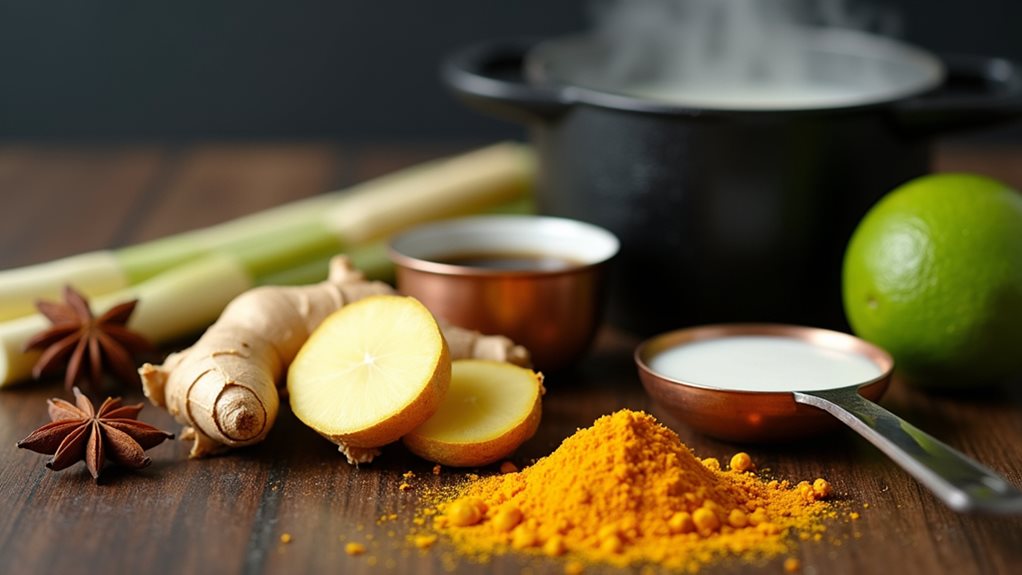
Across the globe, cultural traditions have embraced ginger as a cornerstone of both culinary and medicinal practices, creating distinctive flavor profiles that define regional cuisines.
From ancient kitchens to modern tables, ginger's aromatic intensity transcends borders, weaving cultural narratives through every spicy, warming bite.
Ginger's health benefits have been recognized for centuries, with ancient ginger history tracing back to traditional medicine systems of Asia before spreading worldwide.
You'll find ginger showcasing its versatility across continents:
- Eastern pairing: Combine with soy sauce and garlic in Chinese stir-fries or coconut milk in Thai soups
- Caribbean influence: Use in jerk seasoning, often alongside allspice and thyme
- Indian tradition: Incorporate into chai or chana masala for warming depth
- Western adaptation: Pair with chocolate, citrus, or pineapple for innovative desserts
When preparing ginger for stir-fries, finely mincing ginger helps maximize flavor release while ensuring even distribution throughout the dish.
Unexpected Flavor Matches That Elevate Ginger
While many classic ginger pairings are well-known, you'll be surprised by how chocolate and ginger create a sophisticated flavor combination, with dark chocolate's bitterness perfectly complementing ginger's spicy warmth.
Ginger-infused dairy products offer another unexpected pleasure, as the heat of ginger cuts through the richness of cream, yogurt, or ice cream for a balanced taste experience.
These unconventional pairings transform ordinary desserts and snacks into memorable treats that highlight ginger's versatility beyond traditional applications.
Chocolate Meets Ginger
Few culinary pairings offer the depth and complexity that chocolate and ginger bring together on your palate. This remarkable combination balances the inherent bitterness of dark chocolate with ginger's sweet spiciness, creating a sophisticated flavor experience that's both warming and invigorating.
When experimenting with ginger chocolate, you'll discover that different forms of ginger—crystallized, ground, or fresh—create entirely different textural and flavor profiles.
- Dark chocolate highlights ginger's warmth while tempering its intensity
- Milk chocolate provides a creamy canvas that allows ginger's spicy sweetness to shine
- White chocolate accentuates ginger's savory notes for a unique taste experience
- Adding complementary flavors like cinnamon or orange creates multi-dimensional depth
This pairing has historical roots in both Asian and European traditions, making it a globally celebrated flavor combination. For a beautiful presentation, try creating chocolate-dipped strawberries with a hint of ginger in the chocolate for an elegant dessert that combines luxury and exotic spice.
Ginger-Infused Dairy Delights
The marriage of ginger with dairy creates a surprisingly versatile canvas for culinary exploration. You'll find the warming spice transforms milk, cream, and yogurt into complex flavor experiences where ginger's heat perfectly counterbalances dairy's soothing creaminess.
Try infusing warm milk with fresh ginger and cinnamon for a comforting bedtime beverage, or blend ginger sweetness into ice cream bases with maple syrup for a sophisticated dessert.
For innovative combinations, incorporate turmeric and honey into ginger-infused milk for a golden elixir with anti-inflammatory properties.
Coconut milk provides an excellent alternative base, creating tropical notes that complement ginger's spiciness.
Don't overlook unexpected pairings like ginger with lavender or rose petals—these floral notes create memorable dairy-based confections that will surprise even the most discerning palates.
Creating Balanced Ginger Cocktails and Mocktails
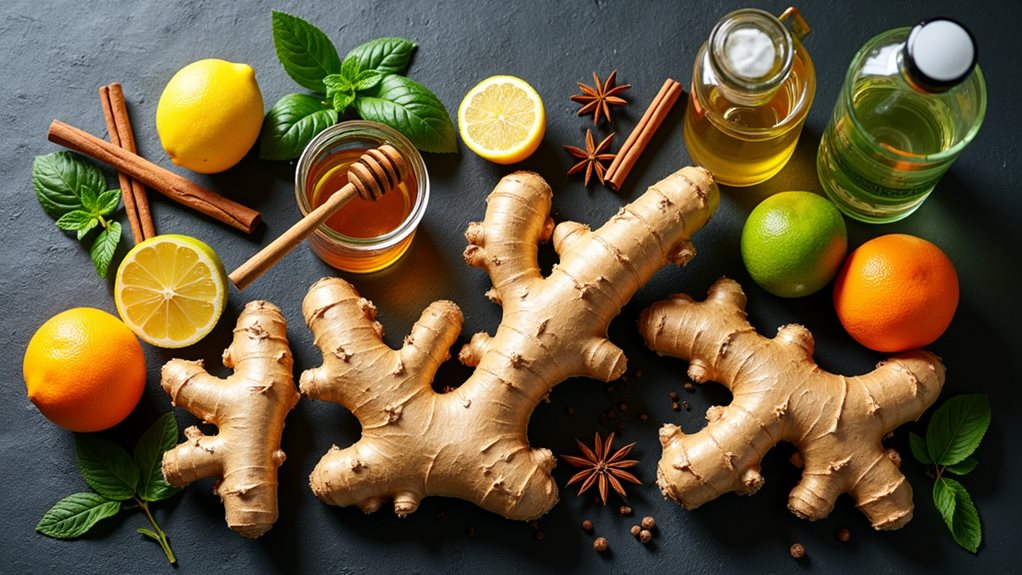
Creating a balanced ginger cocktail or mocktail requires understanding how ginger's distinctive spicy notes interact with complementary flavors.
When mastering ginger cocktail techniques, you'll discover that this versatile root adds complexity to both alcoholic and non-alcoholic beverages.
For successful mocktail variations and spirited drinks, consider these essential pairings:
- Bourbon and ginger create a warming, spicy foundation—perfect for classics like the Sparkling Bourbon & Ginger
- Tequila pairs beautifully with ginger for invigorating drinks like El Diablo
- Homemade ginger syrup offers more control over intensity than store-bought alternatives
- Balance is key—counteract ginger's heat with sweet elements or brighten with citrus
Store your freshly made ginger syrup for up to two weeks refrigerated, ensuring you'll always have this cocktail essential ready.
For enhanced flavor penetration in ginger-infused marinades, massage the mixture into your ingredients or use a vacuum sealer technique.
Seasonal Inspirations for Ginger Recipes
From cocktail counter to seasonal kitchen, ginger's versatility extends throughout the calendar year, offering unique flavor combinations that highlight each season's bounty.
In spring, you'll find lighter applications where ginger complements fresh vegetables like peas and carrots, or enhances floral tea infusions for invigorating beverages.
Summer calls for cooling ginger lemonades and seafood pairings, while autumn welcomes this warming rhizome into harvest soups and pumpkin desserts.
When winter arrives, incorporate ginger into comforting stews and traditional baked goods like gingerbread. For cross-seasonal cooking, try ginger-spiced preserves that work year-round.
These spring inspirations and seasonal recipes demonstrate ginger's remarkable adaptability—whether you're crafting a delicate spring marinade for lamb or a robust winter remedy for colds, ginger's distinctive heat transforms ordinary dishes into extraordinary experiences.
For autumn cooking, consider adding ginger to pumpkin chili recipes for an extra layer of warmth that complements the earthy pumpkin flavors and savory spices.
Ginger and Citrus: A Match Made in Culinary Heaven
When two distinctive flavors collide, ginger and citrus create a sensory symphony that's both timeless and transcendent in culinary applications worldwide.
This partnership, with roots in ancient Asian traditions, has evolved through centuries of ginger history while offering numerous citrus benefits in both sweet and savory dishes.
You'll discover this dynamic duo enhances your cooking in remarkable ways:
- Balancing act – ginger's warming spiciness perfectly counteracts citrus brightness
- Global influence – from Asian stir-fries to Western desserts, this pairing crosses cultural boundaries
- Versatile application – works equally well in beverages, marinades, desserts, and preserves
- Health harmony – combines ginger's anti-inflammatory properties with citrus's vitamin-rich profile
Try mincing fresh ginger with orange zest for marinades or steeping grated ginger with lemon for an invigorating tea that's both traditional and innovative.
Transforming Everyday Dishes With Ginger Accents
The humble ginger root, though unassuming in appearance, possesses remarkable transformative powers that can elevate even the most ordinary dishes to extraordinary culinary experiences.
Beneath ginger's knobby exterior lies culinary magic, waiting to transform the ordinary into the extraordinary.
You'll discover that mastering ginger flavor extraction techniques—whether through grating, mincing, or infusing—can revolutionize your cooking repertoire.
Try sautéing broccoli with garlic and ginger in olive oil, then finishing with almonds for a simple yet sophisticated side dish. For protein options, create a flavorful crust for baked fish by combining grated ginger with bread crumbs and herbs.
Don't overlook soups—a small amount of puréed ginger adds unexpected depth to pumpkin or bean varieties. Proper ginger preservation techniques, like freezing or storing in sherry, guarantee you'll always have this versatile ingredient ready to transform any meal from mundane to memorable.
Much like the French green lentils that maintain their texture beautifully in the Lentils With Spring Greens recipe, ginger retains its distinctive qualities when properly incorporated into various dishes.
Health-Boosting Pairings With Ginger's Medicinal Properties
Ginger's medicinal properties can be amplified considerably when paired with complementary ingredients that share or enhance its therapeutic benefits.
When seeking to maximize ginger health benefits in your daily regimen, consider strategic combinations that target specific wellness goals. You'll find that certain pairings create powerful synergies that multiply ginger's medicinal uses.
- Combine with turmeric to create a potent anti-inflammatory duo, perfect for managing joint pain.
- Mix with lemon and honey for a triple-action immunity booster that soothes coughs and fights infections.
- Blend with green tea to lower blood sugar levels and improve heart health through enhanced antioxidant action.
- Add to Greek yogurt for a digestion-supporting combination that delivers probiotics and calms an upset stomach.
Frequently Asked Questions
Can Ginger Be Paired With Chocolate or Coffee?
Yes, you'll love both ginger chocolate and ginger coffee! The spicy warmth of ginger creates an exciting contrast with chocolate's richness and coffee's boldness, offering innovative flavor experiences you won't find elsewhere.
How Long Does Fresh Ginger Last Compared to Dried?
In a fresh-versus-dried battle that'll blow your mind, your fresh ginger shelf life extends about a month refrigerated or six months frozen, while dried ginger longevity stretches an impressive two years when stored properly.
What's the Best Substitute When a Recipe Calls for Ginger?
For ginger alternatives, you'll want to use ground ginger (1/4 teaspoon per tablespoon of fresh) or galangal (1:1 ratio). Turmeric offers similar health benefits while adding depth to your innovative dishes.
Should Ginger Be Peeled Before Using in Different Recipes?
You'll find peeling methods vary with your needs. Fresh ginger needs peeling for visible uses, but skip it when mincing. Dried ginger doesn't require this step, making it a convenient alternative for innovative cooking approaches.
Can You Freeze Ginger Without Losing Its Flavor Profile?
Like a flavor vault, freezing ginger preserves most of its profile. You'll notice frozen ginger texture becomes easier to grate while still retaining its essential qualities. It's one of the smartest ginger preservation methods available.
Final Thoughts
You've now got a treasure chest of ginger pairings at your fingertips. Whether you're creating sweet treats with cinnamon and chocolate or savory dishes with garlic and soy, ginger's versatility knows no bounds. Don't hesitate to experiment beyond traditional combinations—try unexpected partners like strawberries or white chocolate. By understanding these fundamental flavor relationships, you'll transform ordinary meals into extraordinary culinary experiences that both tantalize your taste buds and boost your health.

